Related Research Articles
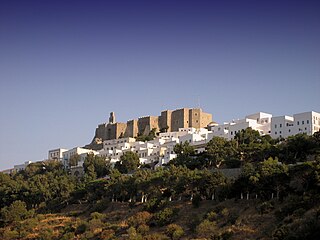
Patmos is a Greek island in the Aegean Sea. It is famous as the location where John of Patmos received the visions found in the Book of Revelation of the New Testament, and where the book was written.
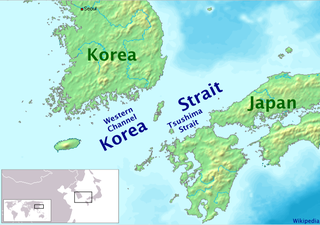
The Korea Strait is a sea passage in East Asia between Korea and Japan, connecting the East China Sea, the Yellow Sea and the Sea of Japan in the northwest Pacific Ocean. The strait is split by the Tsushima Island into the Western Channel and the Tsushima Strait or Eastern Channel. It is economically important, as many shipping lanes pass through the strait, and both Japan and Korea permit free passage through it. In ancient times, both Buddhism and Mongol invaders passed over the strait to reach Japan. More recently, it was the site of the Battle of Korea Strait in the Korean War. A tunnel running underneath the strait connecting Japan and Korea, the Japan–Korea Undersea Tunnel, has been proposed to connect the two countries.
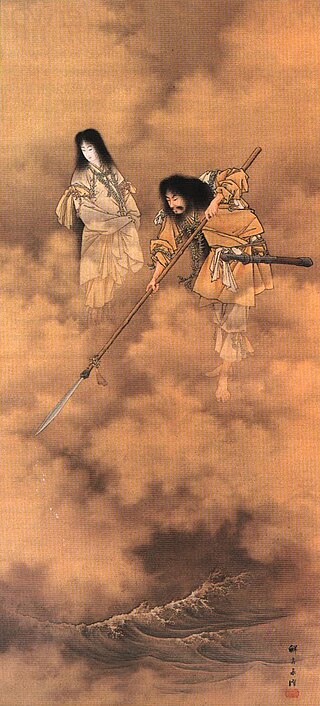
Izanami (イザナミ), formally known as Izanami-no-Mikoto, is the creator deity of both creation and death in Japanese mythology, as well as the Shinto mother goddess. She and her brother-husband Izanagi are the last of the seven generations of primordial deities that manifested after the formation of heaven and earth. Izanami and Izanagi are held to be the creators of the Japanese archipelago and the progenitors of many deities, which include the sun goddess Amaterasu, the moon deity Tsukuyomi and the storm god Susanoo.

Itsukushima (厳島) is an island in the western part of the Inland Sea of Japan, located in the northwest of Hiroshima Bay. It is popularly known as Miyajima (宮島), which in Japanese means "Shrine Island". The island is one of Hayashi Gahō's Three Views of Japan specified in 1643. Itsukushima is part of the city of Hatsukaichi in Hiroshima Prefecture. The island was part of the former town of Miyajima before the 2005 merger with Hatsukaichi.
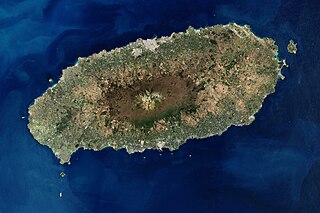
Jeju Island is South Korea's largest island, covering an area of 1,833.2 km2 (707.8 sq mi), which is 1.83 percent of the total area of the country. It is also the most populous island in South Korea; at the end of September 2020, the total resident registration population of Jeju Province is 672,948, of which 4,000 reside on outlying islands such as the Chuja Islands and Udo Island. The total area of the Jeju Special Self-Governing Province is 1,849 km2 (714 sq mi).
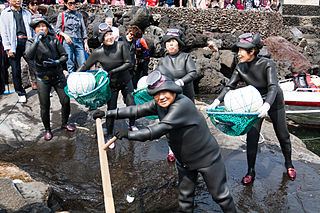
Haenyeo are female divers in the South Korean province of Jeju, whose livelihood consists of harvesting a variety of mollusks, seaweed, and other sea life from the ocean. Known for their independent spirit, iron will and determination, haenyeo are representative of the semi-matriarchal family structure of Jeju.

Munakata Taisha (宗像大社) is a collection of three Shinto shrines located in Munakata, Fukuoka Prefecture, Japan. It is the head of the approximately 6,000 Munakata shrines all over the country. Although the name Munakata Taisha refers to all three shrines—Hetsu-gū, Nakatsu-gū and Okitsu-gū—it is commonly used to refer to Hetsu-gū alone. As documented in Japan's second oldest book, Nihon Shoki, the shrines are devoted to the three Munakata goddesses.
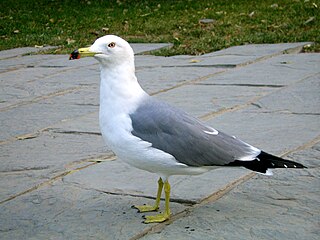
The black-tailed gull is a gull native to shorelines of East Asia.

The daegeum is a large bamboo flute, a transverse flute used in traditional Korean music. It has a buzzing membrane that gives it a special timbre. It is used in court, aristocratic, and folk music, as well as in contemporary classical music, popular music, and film scores. And daegeum has a wide range and has a fixed pitch, so other instruments tune in to the daegeum when playing together.
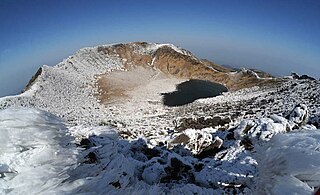
The Jeju Volcanic Island and Lava Tubes is a World Heritage Site in South Korea. It was inscribed as one of the UNESCO World Heritage Sites in 2007 because of the Geomunoreum Lava Tube System and the exhibition of diverse and accessible volcanic features which are considered to demonstrate a distinctive and valuable contribution to the understanding of global volcanism.

Okinoshima is an island off the coast of Munakata, Fukuoka, Japan. It is considered sacred land by the local Munakata Taisha. The island's population consists of a single employee of the shrine. He is one of about two dozen Shinto priests who spend 10-day intervals on the island, praying and guarding against intruders.

A weather god or goddess, also frequently known as a storm god or goddess, is a deity in mythology associated with weather phenomena such as thunder, snow, lightning, rain, wind, storms, tornadoes, and hurricanes. Should they only be in charge of one feature of a storm, they will be called after that attribute, such as a rain god or a lightning/thunder god. This singular attribute might then be emphasized more than the generic, all-encompassing term "storm god", though with thunder/lightning gods, the two terms seem interchangeable. They feature commonly in polytheistic religions, especially in Proto-Indo-European ones.
Eopsin is the goddess of the storage and wealth in Korean mythology and shamanism. She is one of the Gasin, or deities that protect the house. However, unlike other Gasin, who were believed to embody pots, paper, and other inanimate objects, Eopsin is special in that she appears in an animal form. This is because Koreans considered snakes and weasels, who ate mice and rats, holy.

Jeju Chilmeoridang Yeongdeunggut is a shaman ritual that is held on Jeju Island, South Korea at the start of the Korean New Year. The people of Jeju, especially those in the Gwideok, Geumnyeong, and Aewol areas put up 12 posts in the shape of horse heads and colorful silk fabrics to cheer up the goddess Yeongdeung Halmang, who is believed to have visited their place in Korean shamanism. The gut is led by a male dukun until the 15th. At night, lanterns (yeondeung) are installed on the two posts, so this ritual is also called yeondeungje or lantern festival. During the day, the horse carved into the stake looks like a galloping horse, so the gut is also known as yakma bui or galloping horse game.

Getbol are mudflats, or tidal flats, coastal sedimentary systems. They are important habitats for different types of organisms, including migrating birds and marine fauna such as clams, crabs, octopuses, and snails. In 2021, four getbol sites in South Korea were listed as a UNESCO World Heritage Site due to their outstanding natural properties. Each of these sites represent a different type of getbol.
References
- ↑ Cultural Heritage Administration, World Heritage in Korea